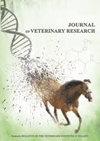Investigation of canine parvovirus occurrence in cats with clinical signs of feline panleukopenia in Slovakia – pilot study
IF 1.3
3区 农林科学
Q2 VETERINARY SCIENCES
引用次数: 0
Abstract
Feline panleukopenia is a contagious viral disease caused by the feline panleukopenia virus (FPV). A closely related pathogen is canine parvovirus (CPV), and amino acid substitutions in this virus allow it to acquire a feline host range. In feline hosts, the disease induced by CPV manifests with similar symptoms to those caused by FPV or milder ones, leading to its underdiagnosis. The aim of this study was to determine the presence of CPV type 2 (CPV-2) in cats with clinical symptoms of panleukopenia and to assess the use of commercial CPV antigen tests for the clinical diagnosis of FPV. Samples from 59 cats from central Slovakia were included in the study. Rectal swabs were collected and clinically tested for parvovirus infection using a commercial antigen test. Antigen-positive samples were confirmed by PCR targeting the viral VP2 gene. The sequences of the PCR products were established with the Sanger method. Of 59 samples, 23 were revealed to be positive for parvovirus infection by both antigen and PCR test (38.9%). Analysis with the National Center for Biotechnology Information BLASTn application showed 99.78–100% pairwise identity with FPV. The mortality rate of parvovirus-infected cats included in this study was 8.69% (2/23). Although feline disease with CPV-2 was not confirmed, the CPV antigen test was able to detect FPV infection.调查斯洛伐克有猫白细胞减少症临床症状的猫体内犬细小病毒的发生情况--试点研究
猫泛白细胞减少症是由猫泛白细胞减少症病毒(FPV)引起的一种传染性病毒疾病。与之密切相关的病原体是犬细小病毒(CPV),这种病毒的氨基酸替换使其能够在猫科动物宿主中传播。在猫科动物宿主中,CPV 诱发的疾病与 FPV 引起的疾病症状相似或症状较轻,导致其诊断率较低。本研究旨在确定具有泛白细胞减少症临床症状的猫体内是否存在 CPV 2 型(CPV-2),并评估商用 CPV 抗原检测在 FPV 临床诊断中的应用。 这项研究包括来自斯洛伐克中部 59 只猫的样本。研究人员采集了直肠拭子,并使用商用抗原检测仪对其进行了副病毒感染临床检测。通过针对病毒 VP2 基因的 PCR 检测确认抗原阳性样本。PCR 产物的序列用桑格方法确定。 在 59 个样本中,有 23 个样本(38.9%)经抗原和 PCR 检测均显示为副病毒感染阳性。利用美国国家生物技术信息中心 BLASTn 应用程序进行的分析表明,与 FPV 的配对一致性为 99.78%-100%。本研究中感染副病毒的猫的死亡率为 8.69%(2/23)。 虽然CPV-2猫病未得到证实,但CPV抗原检测却能发现FPV感染。
本文章由计算机程序翻译,如有差异,请以英文原文为准。
求助全文
约1分钟内获得全文
求助全文
来源期刊

Journal of Veterinary Research
Veterinary-General Veterinary
CiteScore
0.90
自引率
5.60%
发文量
58
审稿时长
18 weeks
期刊介绍:
Journal of Veterinary Research (formerly Bulletin of the Veterinary Institute in Pulawy) is a quarterly that publishes original papers, review articles and short communications on bacteriology, virology, parasitology, immunology, molecular biology, pathology, toxicology, pharmacology, and biochemistry. The main emphasis is, however, on infectious diseases of animals, food safety and public health, and clinical sciences.
 求助内容:
求助内容: 应助结果提醒方式:
应助结果提醒方式:


